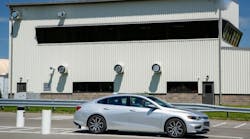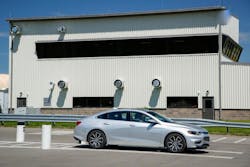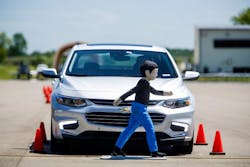The place is specifically designed to test a wide range of safety technologies, everything from rear- and forward-looking camera systems to fully “automatic braking” functionality in emergency situations.
[If you want to view more photos of GM’s new safety testing arena, click here.]
Of course, vehicles operate across a wide variety of road environments … and thus GM’s engineers tried to “re-create” as many of those different topographies at its new test facility. Thus the new site features:
- A 16-acre dynamics pad for testing a variety of robot-controlled and automated vehicles.
- Highway simulation with six lanes, on/off ramps, controlled lighting and road signs that represent specifications around the world.
- A parking test area with different curb types and landscaping detection.
- Pedestrian test area with a 90-degree traffic intersection and specially designed rig for accurate dummy movement.
- Simulated tunnel with walls and posts.
- A building for observation, indoor testing, hoists for test preparation and a robotic control station.
If you think this all seems a little excessive, GM noted that it’s planning to offer some 22 different active safety systems on man of the 2016 versions of various Chevrolet, Buick, GMC and Cadillac models, including:.
City Speed Front Automatic Braking: If the vehicle is traveling at a low speed and the system detects that a front-end collision situation is imminent while following a detected vehicle and the driver has not already applied the brakes, the system automatically applies brakes to help reduce the collision’s severity. The system may even help avoid the collision at very low speeds.- Front Pedestrian Braking: If the system detects that a pedestrian is directly ahead and a collision is imminent, and the driver has not already applied the brakes, the system alerts the driver and, if necessary, automatically applies the brakes to help reduce the collision’s severity or avoid the collision.
- Rear Camera Mirror: Compared to a traditional inside rearview mirror, this rear view mirror display provides a wider, less obstructed field of view to assist when driving, changing lanes, and checking for vehicles and traffic conditions.
- Night Vision: Provides the driver an infrared night vision image of the area lit beyond the headlamps that highlights and provides alerts to detected pedestrians or large animals.
- Curb View Camera: When in Forward gear during low-speed maneuvering (e.g., parking), this system provides the driver a view of the scene immediately ahead of the vehicle on the vehicle’s center stack display to help the driver avoid low-speed collisions into nearby objects, such as curbs, poles, and parked vehicles.
Cynthia Bay (at left), GM’s director of active safety electronics and controls added that concentrating all of the safety technology testing in one location helps improve the testing process.
It also allows for experimentation with future systems as well, she said, such as vehicle-to-vehicle (V2V) technologies that's poised to become a standard feature on the 2017 model Cadillac CTS sedan.
“In addition to helping customers all over the world avoid crashes, many of the technologies we develop and test here are integral to our ongoing V2V communications work and even the development of future autonomous vehicles,” Bay noted.
The V2V dedicated short-range radio communication enables vehicles to “talk” to each other and exchange basic safety data such as speed, location and braking status – complementing existing safety components like radar, camera and ultrasonic sensors.
Ultimately, all of that can help save lives and reduce the severity of vehicles crashes in the bargain; and you can’t argue with that equation.






